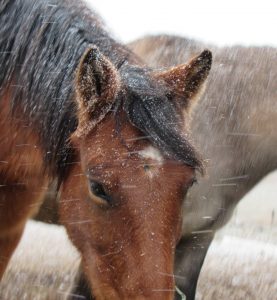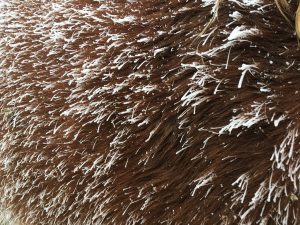 The wind came rolling down the canyon, rustling the pines and then spreading out along the flattened area where the horses would normally be grazing. We had been told a big snow storm was coming, perhaps even a blizzard. I had put hay in the two barns, hoping to encourage the horses to seek shelter in either one. Instead, I watched as the horses moved in a way that looked like they had been assigned places in the pasture. As if choreographed by some voice I could not hear, they turned their hindquarters to the wind. Then, they dropped their heads low, almost reaching the ground. They stood close enough to be companionable but not in a way that any of them touched each other. Then, they waited. There was no anxiety among them. No frantic whinnying. No white-eyed fear. They knew, deep in their bones, what to do. Turn away from the storm, drop their heads to protect their eyes and ears and noses from the wind and snow, and wait it out. The horses knew the storm would end.
The wind came rolling down the canyon, rustling the pines and then spreading out along the flattened area where the horses would normally be grazing. We had been told a big snow storm was coming, perhaps even a blizzard. I had put hay in the two barns, hoping to encourage the horses to seek shelter in either one. Instead, I watched as the horses moved in a way that looked like they had been assigned places in the pasture. As if choreographed by some voice I could not hear, they turned their hindquarters to the wind. Then, they dropped their heads low, almost reaching the ground. They stood close enough to be companionable but not in a way that any of them touched each other. Then, they waited. There was no anxiety among them. No frantic whinnying. No white-eyed fear. They knew, deep in their bones, what to do. Turn away from the storm, drop their heads to protect their eyes and ears and noses from the wind and snow, and wait it out. The horses knew the storm would end.
I have learned many things from horses during my 20 years of researching the horse-human relationship from within Indigenous worldview, and I will be sharing many of them on this blog. One of the most important things I have learned is to listen to the horses. Listening doesn’t mean just with the ears. It means listening to their entire being, to their herd, to the way they interact with life without projecting anything onto it. I have seen horses react in stressful situations such as evacuating from a wildfire. I have seen them need to be removed from fencing in which they have gotten tangled. I have seen them give birth, and I have seen them die. They have lessons they can teach us for this time of pandemic. The one I write about today is to be quiet, go inward, and know that the storm will end.
 Mustangs, horses of the Land, were especially made to weather storms. Their tails have a very low set, which allows it to cover the space between their back legs, keeping them warm. They have smaller ears, meaning there is less surface area to allow heat to escape. They grow thick coats that catch snow and ice on the ends of their fur and keeps their skin warm and dry. These are the tools they have, and they use them successfully because where they live, there are no barns and rarely any trees under which to shelter.
Mustangs, horses of the Land, were especially made to weather storms. Their tails have a very low set, which allows it to cover the space between their back legs, keeping them warm. They have smaller ears, meaning there is less surface area to allow heat to escape. They grow thick coats that catch snow and ice on the ends of their fur and keeps their skin warm and dry. These are the tools they have, and they use them successfully because where they live, there are no barns and rarely any trees under which to shelter.
The horses teach us how we can weather the COVID19 storm. The biggest thing they are teaching us, a lesson that many people still are having a hard time listening to, is to hunker down and wait it out. Not to panic but to do the things we know we need to do until the storm is over. The horses don’t see storms as a disruption to their lives. They recognize that storms are a part of life. Illness is a part of our lives. It always has been. We have become complacent due to modern medicine but COVID19 is a wake-up call. We now have the opportunity to adjust our lives when this storm passes so that we learn how to live with and survive the storms of illness.
We have the ability to weather this storm because we can stay in our homes until this storm is over. We can work from home or we can take this time and do the things we always say we are too busy to do. We can read, exercise, talk to friends and family via the Internet, write poetry, learn a musical instrument, and the list goes on. If we are essential and must work outside the home, then we can come back to it as the safe haven that it is. We have the tools to hunker down. We simply need to recognize them and use them.
When the horses hunkered down for that storm in their pasture, they didn’t know how bad it would be or when it would end. They simply knew that no matter how bad it got, it would end. While we know that this pandemic will become a severe storm, a blizzard, we also know that it will end. And when it does, we will be changed, individually and as a herd. What we do with that change is up to us. Hopefully, we will learn from the horses so that we will be prepared for other storms.
